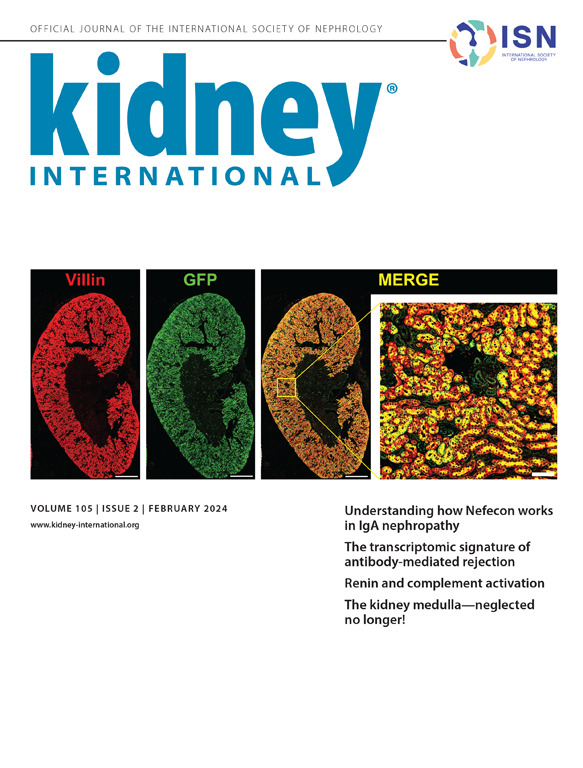Endothelial but not systemic ferroptosis inhibition protects from antineutrophil cytoplasmic antibody–induced crescentic glomerulonephritis
IF 14.8
1区 医学
Q1 UROLOGY & NEPHROLOGY
引用次数: 0
Abstract
Antineutrophil cytoplasmic antibody (ANCA)-associated vasculitides (AAV) are systemic autoimmune diseases featuring small blood vessel inflammation and organ damage, including necrotizing crescentic glomerulonephritis (NCGN). Persistent vascular inflammation leads to endothelial and kidney cell necrosis. Ferroptosis is a regulated cell death pathway executed by reactive oxygen species and iron-dependent lipid peroxidation culminating in cell membrane rupture. Here we show that ANCA-activated neutrophils induced endothelial cell (EC) death in vitro that was prevented by ferroptosis inhibition with Ferrostatin-1, Liproxstatin-1 and small inhibiting RNA against the enzyme AcylCoA Synthetase Long Chain Family Member 4 (ACSL4). In contrast, neither necroptosis nor apoptosis inhibition affected EC death. Moreover, both ferroptosis inhibitors alleviated lipid peroxide accumulation in EC. Increased lipid peroxidation was detected in kidney sections of AAV mice by immunohistochemistry. We generated MPO–/– ACSL4flox Tie2-Cre+ mice lacking ACSL4 specifically in EC (ACSL4ΔEC) to study the significance of endothelial ferroptosis in vivo. ACSL4ΔEC chimeric mice, but not control mice (ACSL4WT), were protected from NCGN in an MPO-AAV bone-marrow transplantation model. These data establish that EC ferroptosis contributes to ANCA-induced glomerulonephritis. However, systemic pharmacological ferroptosis inhibition with Ferrostatin-1 or Liproxstatin-1 did not protect from NCGN in a murine AAV model. Ferrostatin-1 treatment both directly activated T-cell proliferation and indirectly myeloid-mediated T-cell proliferation and polarization in vitro. Conceivably, both effects may cancel the beneficial effect of endothelial ferroptosis inhibition. Mechanistically, we describe the importance of EC ferroptosis for the development of AAV. However, the lack of protection with systemic pharmacological ferroptosis inhibition should discourage clinicians from evaluating this treatment strategy in clinical AAV studies.
内皮抑制而非全身性抑制对抗中性粒细胞细胞质抗体诱导的新月形肾小球肾炎有保护作用。
抗中性粒细胞细胞质抗体(ANCA)相关血管炎(AAV)是一种以小血管炎症和器官损害为特征的全身性自身免疫性疾病,包括坏死性新月形肾小球肾炎(NCGN)。持续的血管炎症导致内皮细胞和肾细胞坏死。铁死亡是一种受调控的细胞死亡途径,由活性氧和铁依赖的脂质过氧化作用最终导致细胞膜破裂。本研究表明,anca激活的中性粒细胞在体外诱导内皮细胞(EC)死亡,而这种死亡可以通过铁抑素-1、利蒲他汀-1和小抑制RNA抑制酰基辅酶a合成酶长链家族成员4 (ACSL4)来预防。相反,坏死下垂和细胞凋亡抑制均不影响EC的死亡。此外,这两种铁下垂抑制剂减轻了EC中脂质过氧化积累。免疫组化检测AAV小鼠肾切片脂质过氧化升高。我们在EC中产生MPO-/- ACSL4flox Tie2-Cre+小鼠特异性缺乏ACSL4 (ACSL4ΔEC)来研究内皮细胞铁下沉在体内的意义。ACSL4ΔEC嵌合小鼠,而不是对照小鼠(ACSL4WT),在MPO-AAV骨髓移植模型中受到NCGN的保护。这些数据表明,EC铁下垂有助于anca诱导的肾小球肾炎。然而,在小鼠AAV模型中,铁他汀-1或利普司他汀-1对铁下垂的系统性药理学抑制并没有保护NCGN。铁抑素-1处理既能直接激活T细胞增殖,也能间接激活骨髓介导的T细胞增殖和体外极化。可以想象,这两种作用都可能抵消内皮细胞抑制铁下垂的有益作用。在机制上,我们描述了EC铁下垂对AAV发展的重要性。然而,缺乏系统性药物抑制铁下垂的保护应该阻止临床医生在临床AAV研究中评估这种治疗策略。
本文章由计算机程序翻译,如有差异,请以英文原文为准。
求助全文
约1分钟内获得全文
求助全文
来源期刊

Kidney international
医学-泌尿学与肾脏学
CiteScore
23.30
自引率
3.10%
发文量
490
审稿时长
3-6 weeks
期刊介绍:
Kidney International (KI), the official journal of the International Society of Nephrology, is led by Dr. Pierre Ronco (Paris, France) and stands as one of nephrology's most cited and esteemed publications worldwide.
KI provides exceptional benefits for both readers and authors, featuring highly cited original articles, focused reviews, cutting-edge imaging techniques, and lively discussions on controversial topics.
The journal is dedicated to kidney research, serving researchers, clinical investigators, and practicing nephrologists.
 求助内容:
求助内容: 应助结果提醒方式:
应助结果提醒方式:


